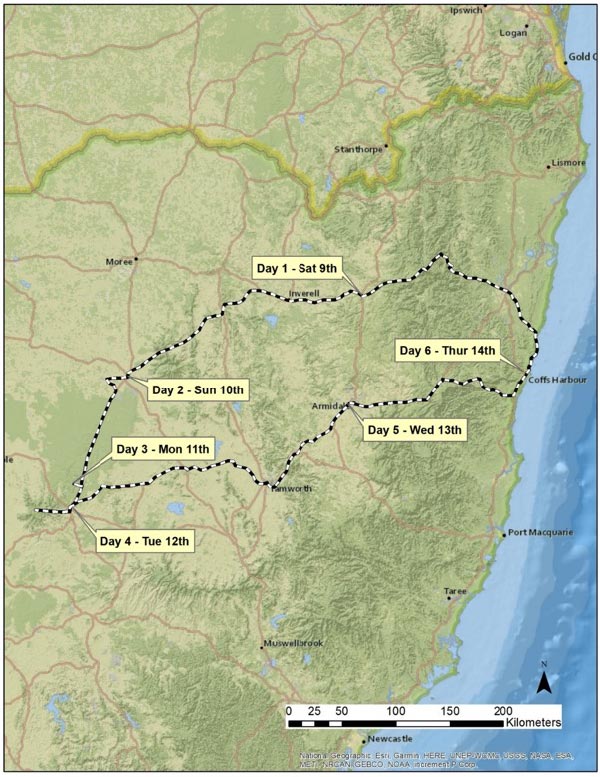Post-symposium Excursion
Post-symposium Botanical Field Excursion – Mountains to Western Woodlands Field Trip
Leads: Greg Steenbeeke and John T. Hunter
The details of this post-symposium excursion are being finalised and may change due to road conditions and access. An estimated upper end cost excluding evening meals and the last nights’ accommodation is likely to be approximately around $800.00 for twin share accommodation to $1,400.00 AUS for a private room. This price may be reduced or increase by the time of the field trip due to savings or increases due to the number of individuals who decide to attend. As expressions of interest and deposits are made, we will be able to be more precise in terms of costs involved.
The six-day field trip will depart from Opal Cove, Coffs Harbour, on Saturday, 9th of September, and return to Coffs Harbour on Thursday, 14th of September. This excursion will highlight the vast changes encountered crossing the high-altitude eastern escarpment of the New England Tablelands (>1,000 m a.s.l., mean rainfall >2,000 mm p.a.) down on to the western slopes and plains (ca. 200 m a.s.l., <600 mm p.a.).
Day 1: Saturday, 9th of September: Coffs Harbour to Glen Innes

On the first day we travel from Coffs Harbour to the Gibraltar Range and Washpool National Parks which are part of the World Heritage-listed Gondwana Rainforests of Australia. Our first stop will be at Washpool National Park where we will take a low-grade walk at Coombadja, which will take us through rainforest along the banks of Coombadjha Creek as well as other forest types along the way (https://www.youtube.com/watch?v=y5iQu1J-6Ms). Next, we will travel to the Mulligans Hut in Gibraltar Range National Park. Here we visit granite landscapes dominated by sclerophyll woodlands, forests and bogs (https://www.youtube.com/watch?v=F72JGvl2wAA). After our walks, we travel to our accommodation in the small tablelands township of Glen Innes situated in the heart of the Northern Tablelands of NSW, part of the Great Dividing Range of the east coast of Australia. Glen Innes was founded in 1852 and has an elevation of 1,062 m and a population of about 6,000. https://www.researchgate.net/publication/293104181_Vegetation_and_floristic_diversity_in_Gibraltar_range_and_part_of_washpool_national_parks_New_South_Wales
Accommodation is likely to be standard motel rooms with individual and twin share rooms available.
Day 2: Sunday, 10th of September: Glen Innes to Narrabri
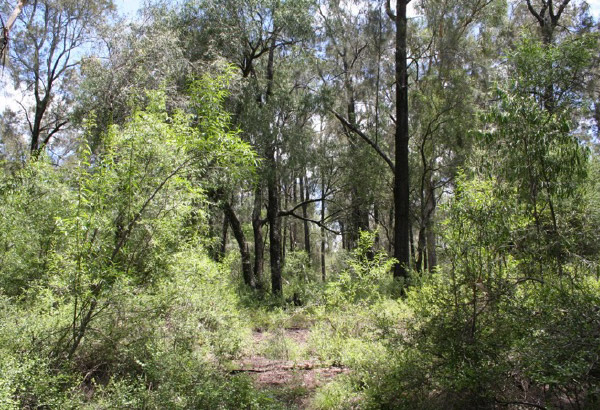
Our travels will now take us on a journey of decreasing rainfall and altitude (1,062 m to 226 m) as we drop off the Great Divide down on to the western slopes and edge of the western plains. We will make several small stops along the way in order to highlight some of the significant changes in vegetation. The first stop will be to the small Barayamal National Park situated on the edge of the township of Inverell. Here we will see a good example of the critically endangered grassy box gum woodlands: https://www.researchgate.net/publication/280843709_Vegetation_and_flora_of_Barayamal_Nature_Reserve.
Our next stop will be outside the small township of Bingara at Derra Derra Ridge to view typical western slopes sclerophyll woodlands and examples of the endangered semi-evergreen vine thickets: https://www.researchgate.net/publication/279944070_Vegetation_and_flora_of_Derra_Derra_Ridge.
We then head further west making a short stop at an ancient rocky creek glacial area: https://www.bingara.com.au/about-bingara/landscape/geologicalnatural-wonders/rocky-creek-glacial-area/ before heading for a short walk to Sawn Rocks in Mt Kaputar National Park: https://www.youtube.com/watch?v=wOz0_7FIJJ0. Depending on time, we may also make a short stop at Killarney Conservation area just outside of Narrabri to look at typical Bulloak (Allocasuarina luehmannii) and White Cypress Pine (Callitris glaucophylla) woodlands https://www.researchgate.net/publication/279964419_Vegetation_of_Killarney_State_Conservation_Area, before finally stopping for the night at Narrabri. Narrabri is one of the major centres within the North Western Slopes of NSW bordering on the open western plains and is the centre for a large cotton growing industry. The township was founded in 1860 and currently has a population of around 6,000.
Accommodation is likely to be standard motel rooms with individual and twin share rooms available.
Day 3: Monday, 11th of September: Narrabri to the Pilliga
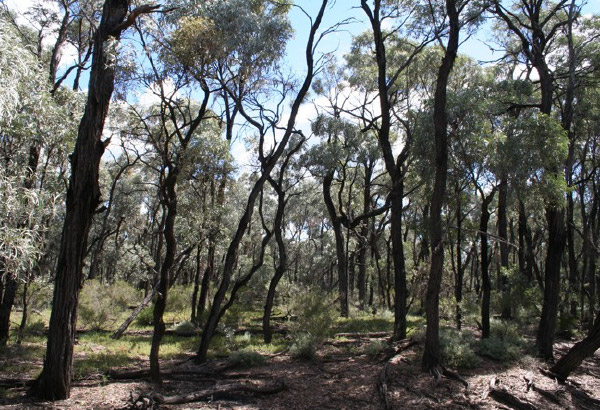
Today we venture into the alluvial floodplains of the western plains and see communities found on cracking clay and Pilliga outwash duplex soils including grasslands, acacia (Brigalow, Weeping Myall) and casuarina (Belah)- dominated communities, open sclerophyll woodlands and ephemeral inland wetlands before travelling through the highly diverse ‘million wild acres’ of the Pilliga sandstones.
Depending on weather and access, we will visit Yarrie Lake, an ephemeral wetland (https://www.researchgate.net/publication/271310484_Ephemeral_wetlands_of_the_Pilliga_Outwash_northwest_NSW) and pass by one of the last remaining stands of Brigalow (Acacia harpophylla) on gilgai soils. Brigalow was a once dominant vegetation type across millions of hectares, but is now reduced to isolated small stands (https://www.researchgate.net/publication/279964285_Vegetation_and_floristics_of_Brigalow_Park_and_Claremont_Nature_Reserves).
From here we travel across the Pilliga outwash with its mixture of Eucalyptus, Corymbia, Callitris and Allocasuarina-dominated communities into the extensive remnant woodlands of the Pilliga sandstones. This area, known as the ‘million wild acres’, contains the largest area of remnant western woodlands in NSW and contains a high diversity of species. We will finish the day with a stay near the Dandry Gorge region in the southern Pilliga (https://www.researchgate.net/publication/279963584_Vegetation_and_flora_of_Timallallie_National_Park_Yarragin_National_Park_and_Dandry_Gorge_Aboriginal_Area).
Accommodation is likely to be shared accommodation at Pilliga Pottery Farm stay: https://www.barkalafarmstay.com.au/?v=322b26af01d5
Day 4: Tuesday, 12th of September: The Pilliga to the Warrumbungles
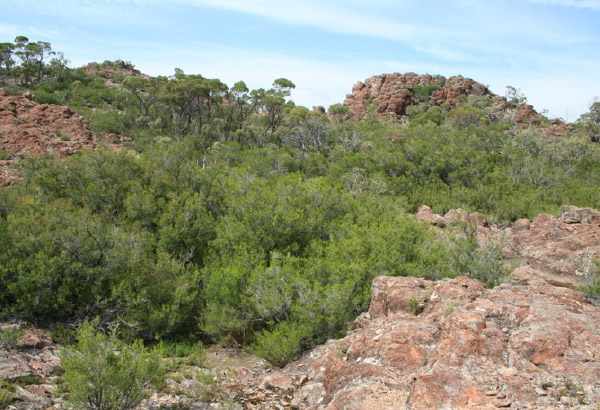
The fourth day will be spent largely in volcanic areas of the Warrumbungle National Park where we will walk through ancient volcanic plugs and see diverse sclerophyll woodlands and shrublands. This is an area known for its clear skies and so contains the Siding Springs Observatory. Here we will take walks in the national park, which is still recovering from a landscape-scale fire in 2013. The reserve contains a high diversity of plants, given its highly diverse topography and mix of flora with western, eastern and southern affinities. We will finish the day in the small township of Coonabarabran with a population of around 2,500 (elevation, 505 m). https://www.researchgate.net/publication/279945737_Vegetation_and_flora_of_Warrumbungle_National_Park
Accommodation is likely to be standard motel rooms with individual and twin share rooms available.
Day 5: Wednesday, 13th of September: the Warrumbungles to Armidale
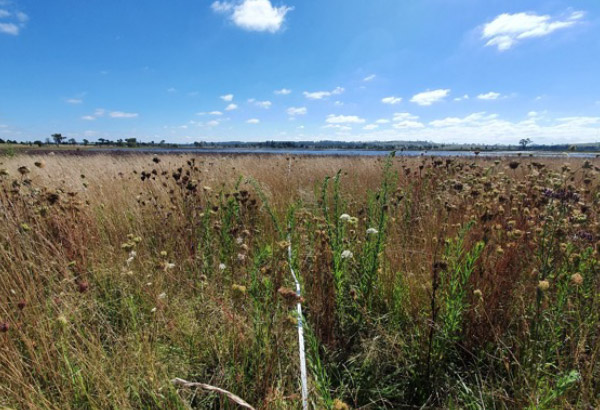
Day five will be our longest travel day as we start to head back towards the coast. We will travel through a variety of western woodlands making opportune stops to sample the variety seen before travelling back up on to the New England Tablelands to Armidale. We will stop at some upland vegetation types including endangered ephemeral upland lagoons: https://dynamiclagoons.une.edu.au/#!/map
https://www.researchgate.net/publication/237428566_Montane_lakes_lagoons_of_the_New_England_Tablelands_Bioregion.
Accommodation is likely to be standard motel rooms with individual and twin share rooms available.
Day 6: Thursday, 14th of September: Armidale to Coffs Harbour

Our last day will take us back to Coffs Harbour, travelling across a highland plateau between the Macleay and Guy Fawkes gorges and wild rivers country. This route is known as the Waterfall Way, and along it, we will stop and visit some of these waterfalls and see dry rainforests that cling to incised steep gullies (https://www.nationalparks.nsw.gov.au/things-to-do/picnic-areas/wollomombi-falls-picnic-area). We will then visit upland peatlands and high-altitude woodlands and forests of the upland granite country in Cathedral Rocks National Park: https://www.nationalparks.nsw.gov.au/visit-a-park/parks/cathedral-rock-national-park
No accommodation is included in the pricing for this last night.
